Contents
Sunflower
The sunflower (Helianthus annuus) is a tall, fast-growing flowering plant famous for its large, daisy-like blooms. It belongs to the Asteraceae family (the daisy or sunflower family). Sunflowers are known for their striking appearance: a prominent central disk packed with tiny florets, surrounded by bright yellow flowers (ray petals) that resemble the sun. They stand out among other types of flowers for their size and vivid color, making them a quintessential symbol of summer in gardens and farms alike.
Native to North America, the sunflower has been cultivated for centuries both as an ornamental plant and as a valuable crop. This hardy annual thrives in warm seasons and produces edible seeds rich in oil and nutrients. In the garden, sunflowers are prized for their cheerful summer blooms and bold presence. They are often grown not only for beauty but also for practical uses – as cut flowers for arrangements, as a source of food for wildlife, and even as natural screens or backdrops in landscapes.
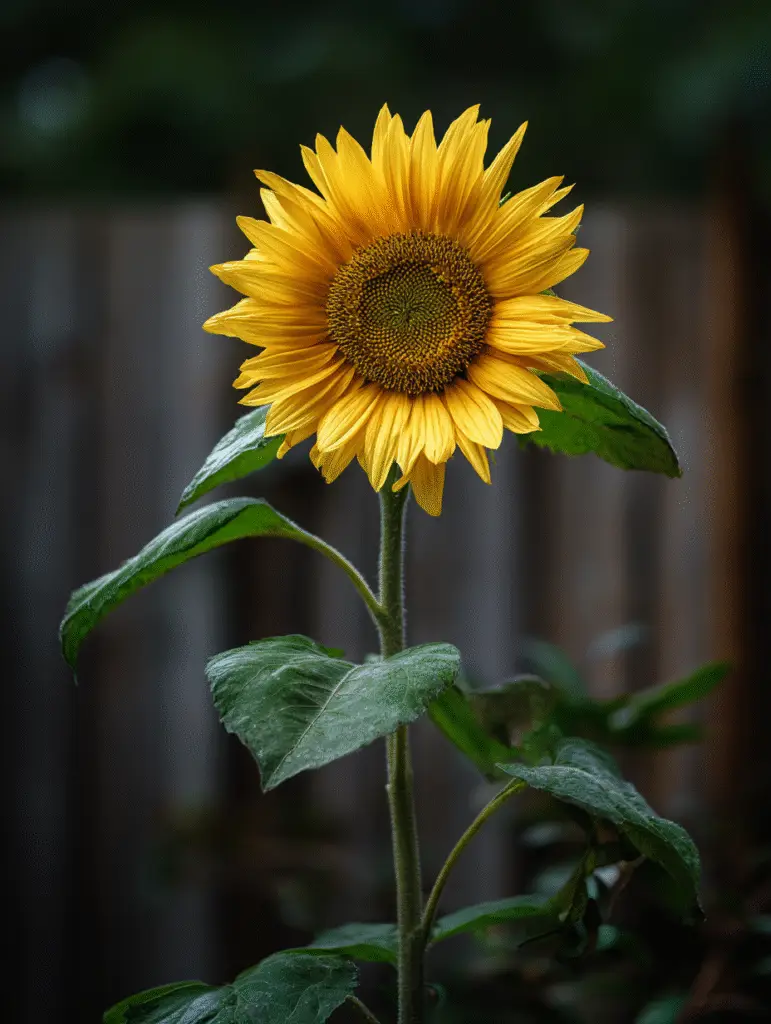
🌱 Taxonomy and origin
The common sunflower is classified as Helianthus annuus, where Helianthus derives from Greek meaning “sun flower” (helios = sun, anthos = flower). It is one of roughly 70 species in the genus Helianthus, which includes both annual and perennial sunflowers. Sunflowers belong to the Asteraceae family, a large plant family characterized by composite flower heads (many small florets forming one “flower”). Within this family, the sunflower’s giant bloom is actually composed of hundreds of tiny individual flowers – a botanical feature typical of daisies and asters.
Helianthus annuus originated in the western regions of North America. It was domesticated by indigenous peoples in what is now the United States and Mexico thousands of years ago. By the 16th century, Spanish explorers had introduced the sunflower to Europe, where it quickly gained popularity as an ornamental and oilseed plant. Today, sunflowers are grown worldwide in both temperate and subtropical regions. Despite the many cultivated varieties, all common sunflowers share the same basic taxonomy and ancestry tracing back to their North American origin.
🌸 Bloom time
Sunflowers typically bloom during the warmest part of the year. In most climates they are classic summer blooms, opening from mid-summer into early fall. After sowing seeds in spring, sunflowers will take around 70 to 100 days to flower, depending on the variety and growing conditions. Once blooming begins (often in July or August for spring-planted sunflowers), many varieties will continue to flower for several weeks. Single-stem sunflower varieties generally produce one grand flower head in mid-summer. In contrast, branching sunflower cultivars bear multiple smaller flower heads sequentially over the late summer months, extending the bloom period into the fall until cold weather arrives.
The flowering period of a sunflower is not only visually striking but also ecologically important. The large blooms provide abundant pollen and nectar, attracting bees, butterflies, and other pollinators. Gardeners often notice their sunflowers teeming with bee activity on sunny days. This makes sunflowers valuable pollinator-friendly plants in addition to being beautiful ornamentals. Deadheading (removing spent blooms) on branching varieties can encourage further blooming, though many growers leave the late-season flowers in place to mature into seed heads for birds or harvest.
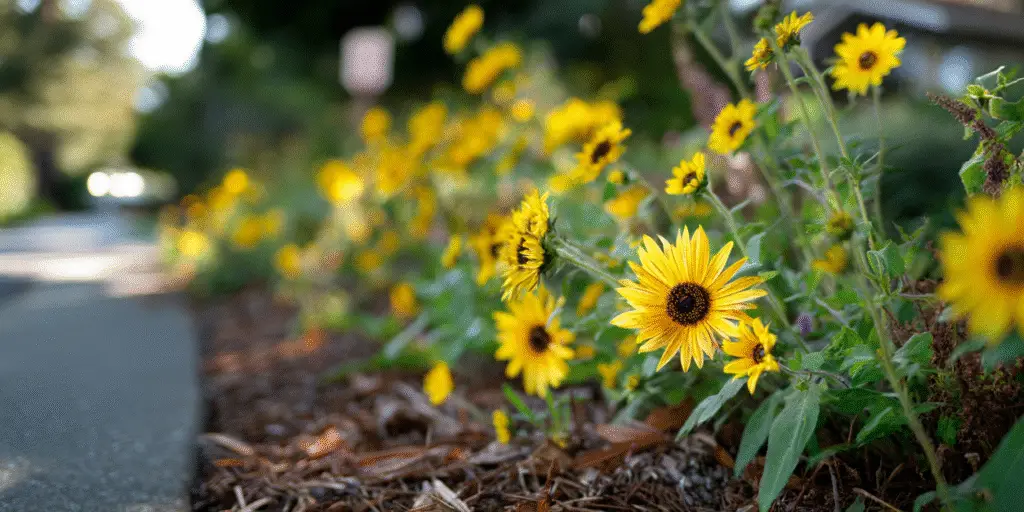
📏 Height and spread
Sunflowers are renowned for their impressive height. Many garden sunflowers will reach 5 to 10 feet tall (approximately 1.5 to 3 meters), which means they can easily tower over other plants. This makes tall sunflowers ideal for the back of garden borders or along fences, where they form a dramatic backdrop. Some giant cultivars can grow even taller – well above 12 feet given optimal conditions. On the other end of the spectrum, breeders have created dwarf sunflower varieties that stay much shorter (around 1 to 3 feet tall), suitable for containers or front-of-bed plantings. The ultimate height of a sunflower depends on its variety and growing conditions (soil fertility, moisture, and space).
In terms of spread, single-stem sunflowers have a narrow footprint – often only 1 to 2 feet wide – since they typically consist of one main stem with large leaves and a single flower head. Branching sunflowers form bushier plants with multiple stems, these can spread 2 to 4 feet wide as they send out side branches bearing additional blooms. Given their stature, tall sunflowers should be positioned so they won’t shade smaller neighboring plants. Their sturdy, upright stems usually support the blooms well, but very tall varieties may benefit from staking or protection from strong winds to prevent toppling.
☀️ Light
True to their name, sunflowers thrive in plenty of sunshine. They are quintessential sun-loving plants, requiring full sun for the best growth and flowering. “Full sun” means at least six to eight hours of direct sunlight per day. In open garden conditions, more sun is usually better for sunflowers – ample light leads to stronger stems and larger blooms. If sunflowers are grown in partial shade or if they receive less than about six hours of sun, they tend to become leggy (tall and spindly) and may produce smaller flowers.
Sunflowers have an interesting relationship with the sun: young sunflower buds exhibit heliotropism, meaning they turn to face the sun as it moves across the sky each day. This trait maximizes their light exposure during the growth phase. Once the blooms open, sunflowers usually maintain an eastward-facing orientation. While this sun-tracking behavior is fascinating, the key takeaway for gardeners is to plant sunflowers in an open, unobstructed location where they will soak up all the sun they need.
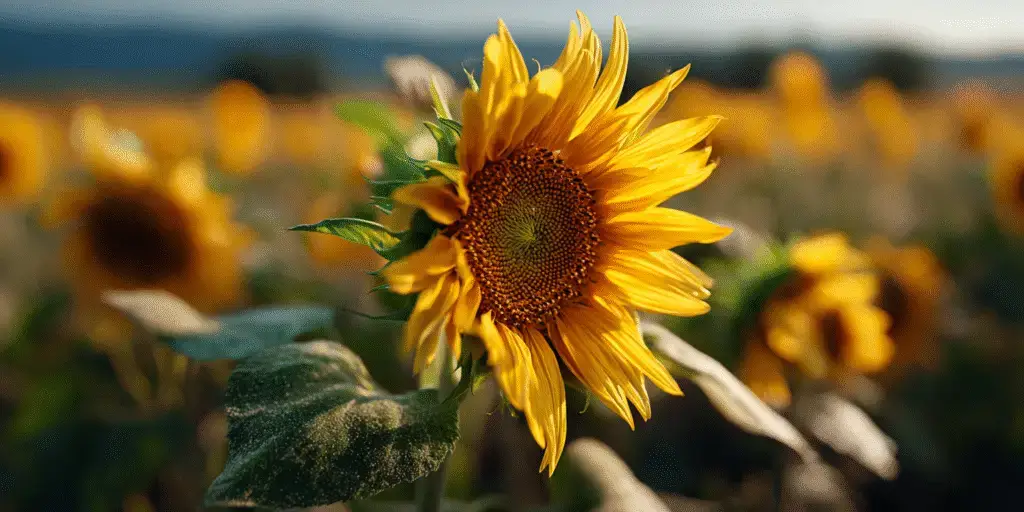
💧 Water
Sunflowers appreciate consistent moisture, especially during their early growth and flowering stages, but they are relatively resilient once established. As a rule, provide moderate watering and avoid overwatering. The plants have deep taproots that help them access water in the soil and also confer a degree of drought tolerance. In practice, this means sunflowers can withstand short dry spells, but prolonged drought will cause stress – evident by drooping leaves and reduced flower size.
It’s best to water sunflowers when the top inch or two of soil has dried out. Deep, infrequent watering encourages the roots to grow downward and strengthens the plants. During hot summer days, large sunflowers can be surprisingly thirsty due to their broad leaves and rapid growth. Ensure they receive sufficient water in heat waves to prevent wilting. At the same time, good drainage is important, waterlogged soil can lead to root rot or fungal issues. Striking a balance – moist but not soggy soil – will keep sunflowers healthy and vigorous throughout the season.
🌍 Soil and pH
Sunflowers are adaptable to a variety of soil types, but they perform best in well-draining, nutrient-rich soils. A loamy soil that retains moisture yet doesn’t stay waterlogged is ideal. These plants have vigorous root systems and appreciate soil with some depth and texture, allowing their roots to penetrate easily. If the native soil is compacted or heavy clay, incorporating organic matter (like compost) will improve its structure and fertility for sunflowers.
Regarding soil pH, sunflowers are not very fussy. They can tolerate a broad pH range from slightly acidic to slightly alkaline. In general, a neutral to mildly acidic soil (around pH 6.0 to 7.5) is considered optimal for nutrient availability. However, sunflowers have been observed growing in soils outside that range as well – they are hardy plants that can adapt to less-than-perfect conditions. The main soil requirement is to avoid extremes: extremely acidic or highly alkaline soils may hinder growth indirectly by limiting nutrient uptake. For most gardens, typical garden soil will suffice for sunflowers as long as it is not overly wet or infertile. Periodic feeding or soil amending can be beneficial since sunflowers are fast growers that can deplete soil nutrients over their growing season.
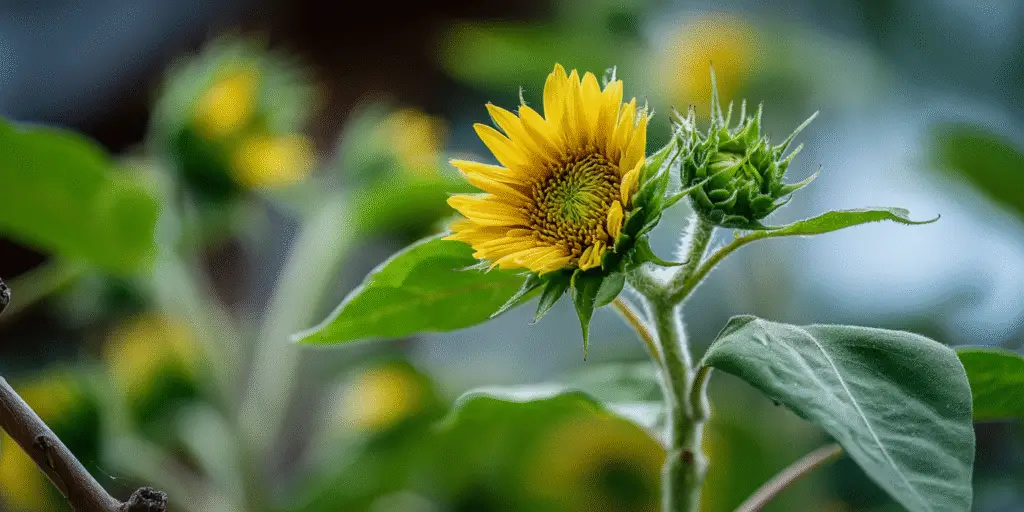
❄️ USDA hardiness
The common sunflower is typically grown as an annual in all but the warmest regions, so USDA hardiness zones are less critical compared to perennial plants. In practice, gardeners across a wide range of zones (approximately USDA Zones 2 through 11) can cultivate sunflowers during the frost-free season. Sunflower seeds will germinate once soil temperatures are warm enough (usually above 50°F or 10°C), and the plants grow during late spring and summer. They are not frost-tolerant – even a light frost can damage or kill young sunflower seedlings, and mature plants will also succumb when hard frosts arrive in fall.
Because sunflowers complete their life cycle in one growing season, they do not overwinter (speaking of the annual H. annuus). Instead, new seeds must be sown each year. In tropical or subtropical climates (zones with very mild winters), sunflowers might be sown in different seasons or potentially naturalize by self-seeding year after year. For perennial sunflower species (such as Helianthus maximiliani or Helianthus decapetalus), cold hardiness becomes relevant – some of those perennials can survive winter in zones 4-9, resprouting in spring. However, for the common annual sunflower, the important point is timing the planting to the local growing season: sow seeds after the last spring frost and allow enough time (2-3 months) for the plants to grow, bloom, and set seed before autumn frosts.
🌼 Propagation and longevity
Sunflowers are most commonly propagated by seed. They are easy to grow from seeds sown directly into the garden. It is recommended to sow sunflower seeds after the last frost date, once the soil has warmed up in spring. Plant the seeds about 1 inch (2.5 cm) deep, and space them 1 to 2 feet apart (depending on the expected mature size of the variety). The seeds germinate quickly, often within 7 to 10 days under warm conditions. Because sunflowers have sensitive taproots, direct sowing is preferred to avoid transplant shock. However, they can be started indoors in biodegradable pots a few weeks before the frost has passed, then transplanted carefully outside without disturbing the roots.
As fast-growing annual flowers, sunflowers complete their entire life cycle in a single season. From germination to flowering and seed production typically takes only a few months. Once a sunflower plant has bloomed and its seeds mature, the plant will naturally senesce (age and die back). The longevity of an individual sunflower is thus just one growing season. Gardeners can extend the presence of sunflowers by succession planting – sowing seeds a few weeks apart in spring to early summer – thereby staggering bloom times and enjoying continuous flowers for a longer period. Additionally, sunflowers often self-sow: seeds that drop from a mature head in fall may sprout the following year if they survive the winter, creating volunteer seedlings. Collecting and saving seeds from the best plants is another way to propagate sunflowers for the next season, ensuring a fresh generation since the parent plants will not live beyond the current year.
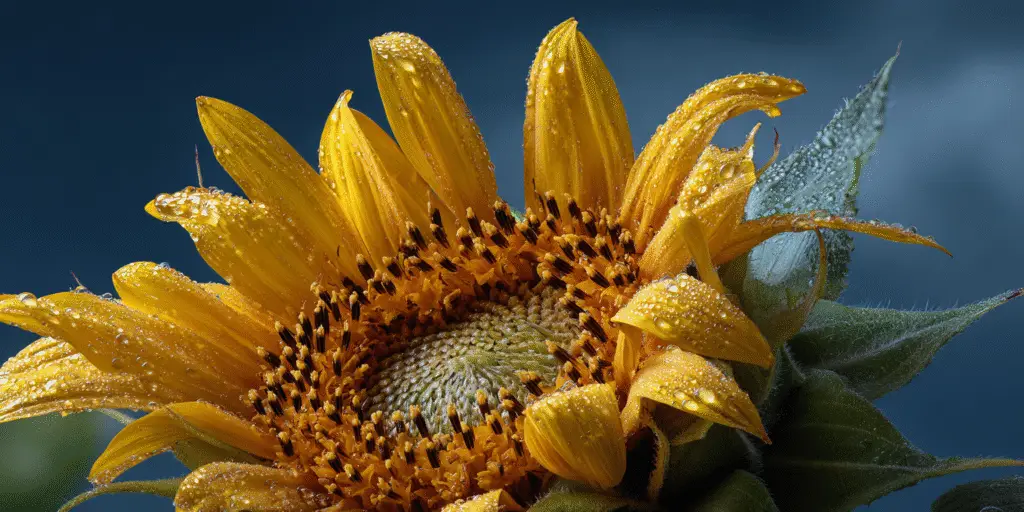
👃 Fragrance
Despite their bold appearance, sunflowers are not particularly known for fragrance. The blooms of Helianthus annuus have a very mild scent at best. Most people would describe sunflower fragrance, if any, as subtly earthy or slightly sweet, but it is faint and easily overlooked. Unlike roses, lilies, or other strongly perfumed blossoms, sunflowers do not perfume the air in a garden. Their strategy for attracting pollinators relies more on visual cues (bright color and plentiful pollen/nectar) than on scent.
In practical terms, this means gardeners don’t grow sunflowers for their smell – the appeal is in the dramatic flowers and seeds. When used as cut flowers indoors, sunflowers won’t add a noticeable floral aroma to a room. This can be an advantage for those who are sensitive to strong floral fragrances, as sunflowers provide visual impact without overwhelming scent. Overall, the lack of strong fragrance does not detract from the sunflower’s popularity, it remains a beloved garden plant for its looks and utility rather than its aroma.
⚠️ Toxicity and pet safety
Sunflowers are generally considered non-toxic, which is good news for gardeners with pets or children. According to the ASPCA and other plant safety databases, Helianthus annuus is not poisonous to cats, dogs, or horses. If a curious pet bites into sunflower leaves or petals, it should not suffer toxic effects. At most, ingesting a large amount of any plant material might cause minor digestive upset or vomiting, but sunflowers do not contain any known harmful compounds for common household animals. This makes sunflowers a safe choice for gardens frequented by pets.
In fact, sunflower seeds are commonly used in pet and wildlife feeds (for example, birdseed mixes often contain sunflower seeds, which many birds and small mammals enjoy). Humans also consume sunflower seeds regularly as snacks and as a source of cooking oil, further highlighting their non-toxicity. It is still wise to prevent pets from eating large quantities of garden plants simply to avoid stomach upset or accidental damage to the plants. But if a dog or cat chews on a sunflower stalk or fallen bloom, owners can be reassured that it is not dangerous. Always ensure that any pesticides or treatments used on ornamental sunflowers are pet-safe, since those chemicals (rather than the plant itself) could present a hazard if ingested.
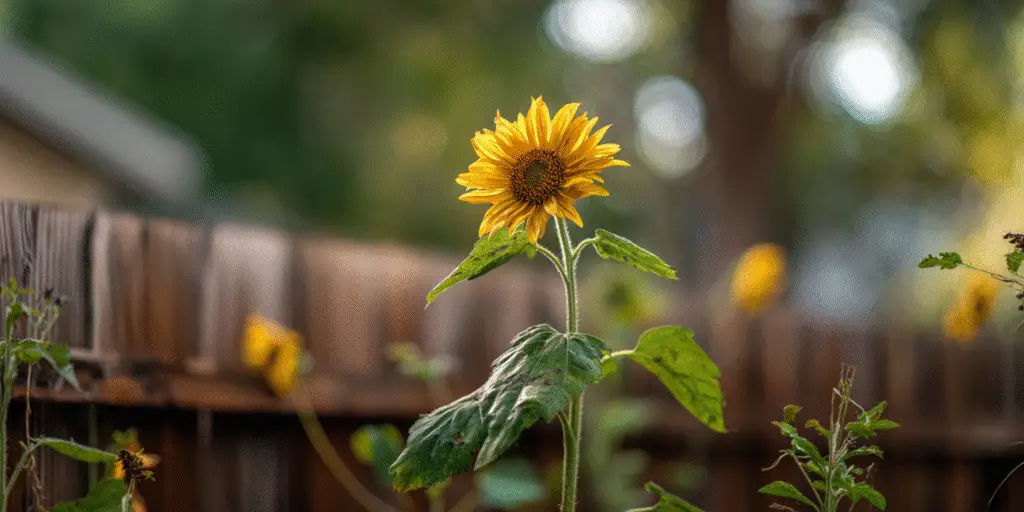
🌿 Vase life
Sunflowers are popular as cut flowers thanks to their bold form and cheerful color. When cut at the right stage and cared for properly, a sunflower bloom can have a respectable vase life. On average, cut sunflowers last about 5 to 10 days in a vase. Some may hold up slightly longer (up to roughly two weeks) under ideal conditions and with prompt care. To maximize vase life, it is best to harvest sunflowers when the petals are just starting to unfurl (just before they are in full bloom) rather than after they are fully open. Early morning is a good time to cut sunflowers, as the plants are well-hydrated and the blooms are most fresh.
After cutting, any leaves on the lower portion of the stem should be removed to prevent rot in the water. The stems should then be placed promptly in a vase of clean, lukewarm water. Using a floral preservative in the water can help inhibit bacterial growth. Sunflower stems tend to absorb water rapidly, so it is important to check the vase water level daily and refill it as needed. Replacing the water with fresh solution and re-cutting the stem ends every few days will further help extend the blooms’ display. Note that some modern sunflower cultivars are bred to be pollen-free (they lack pollen shed) specifically for the cut flower market – these have the advantage of not dropping pollen on surfaces and sometimes a slightly longer vase life. Even though sunflowers may not last as long as some smaller cut flowers, their striking presence makes them a favorite in summer bouquets.
🐛 Pests and diseases
Common Pests
Sunflowers are generally hardy plants, but they can still attract various insects and other garden pests. Among insect pests, aphids are frequently seen on sunflowers – these small sap-sucking insects cluster on stems and buds and can weaken the plant if infestations are heavy. Caterpillars, such as the sunflower moth larvae, may chew through petals or bore into flower heads, causing damage to the blooms. Various beetles (for example, leaf-chewing beetles) and weevils also sometimes feed on sunflower foliage or developing seeds. In many instances a healthy sunflower tolerates minor insect feeding, but severe infestations might require intervention (such as using insecticidal soap or hand-picking pests off the plant). It’s worth noting that wildlife can “pester” sunflowers as well: birds and squirrels are notorious for attacking mature flower heads to eat the seeds, and even deer or rabbits might nibble on young sunflower leaves and stems.
Common Diseases
Sunflowers can also suffer from several plant diseases, especially in humid or wet weather. Fungal issues are among the most common. Powdery mildew often appears as a white, powdery coating on leaves by late summer, particularly if air circulation around the plants is poor. Rust fungi create reddish-brown spore pustules on leaves, which can weaken the foliage. Downy mildew may infect young sunflowers in cool, damp conditions, causing stunted growth and a fuzzy mold under the leaves. Soil-borne pathogens like Verticillium wilt and Sclerotinia (white mold) can lead to wilting, stem rot, or plant collapse, especially in poorly drained soils or if sunflowers are grown in the same spot every year. There is also a disease called aster yellows, caused by a microorganism transmitted by leafhoppers, which results in deformed greenish flowers and yellowed, stunted plants, any sunflower showing these symptoms should be removed to prevent spread.
Good gardening practices help prevent many problems. Plant sunflowers with enough spacing to ensure good air flow, avoid overhead watering that keeps foliage wet, and rotate sunflower plantings to new areas each year to reduce soil disease buildup. Clearing away and discarding any diseased plant debris at the end of the season is also important. Fortunately, sunflowers are fairly tough, and with proper care and attention, serious pest or disease outbreaks are not very common in-home gardens.
FAQs
Do sunflowers come back every year?
Traditional garden sunflowers (Helianthus annuus) are annual plants, meaning they complete their life cycle in one year. They will not regrow from the same root the next year. Once an annual sunflower finishes flowering and sets seed, the plant dies. To have sunflowers in the garden each year, gardeners must replant them from seed each spring. (There are perennial sunflower species in the Helianthus genus, but those are less common and are distinct from the typical annual sunflower.)
How long does it take for sunflowers to bloom from seed?
Sunflowers grow relatively quickly. On average, it takes about 2 to 3 months (roughly 70 to 90 days) from planting a sunflower seed to getting a bloom. The exact timing can vary with the variety – some fast-maturing dwarf sunflowers might bloom in as little as 60 days, while giant varieties or those with branching habits might take closer to 90 or 100 days. Warm weather, ample sunlight, and good soil nutrition can help speed along the growth and flowering process.
How tall can sunflowers grow?
The height of a sunflower depends on its variety. Many common varieties in gardens reach between 5 and 10 feet tall (1.5 to 3 meters). Some giant sunflower cultivars can grow exceptionally tall – 12 to 15 feet is not uncommon in ideal conditions, and the tallest sunflowers on record have exceeded 20 or even 30 feet in height. On the other hand, dwarf sunflower varieties may only grow 1 to 3 feet tall. When choosing sunflower types for a garden, it’s important to note the expected height so they can be given appropriate space and support.
Can sunflowers be grown in pots or containers?
Compact or dwarf sunflower varieties can grow well in containers, provided the pot is large enough. A deep pot (at least 12-16 inches in depth) with good drainage and filled with rich potting mix is recommended to support healthy root development. Potted sunflowers should be placed in a very sunny spot and watered regularly, since containers dry out faster than garden soil. Keep in mind that very tall sunflower varieties are not ideal for containers because their height and weight can cause them to tip over, it’s best to choose smaller varieties for growing in pots.
What should I do with sunflowers after they finish blooming?
After a sunflower bloom fades, there are a few options. If the goal is to harvest the sunflower seeds, allow the flower head to mature on the stem until the back of the head turns yellow-brown and the seeds plump up. At that point, the flower head can be cut and dried further in a sheltered spot, or the seeds can be rubbed out by hand for eating or for replanting. If the goal is to feed wildlife, the spent flower heads can be left on the plant – birds (like finches and cardinals) will perch on the stalks to pluck out and eat the seeds. Once the plant has completely dried and died back, it can be pulled up and composted or disposed of. In the case of branching sunflowers, the gardener can trim off spent blossoms to tidy the plant, but eventually those too will finish blooming and the whole plant can be cleared at season’s end.
Are sunflowers toxic to cats or dogs?
No. Sunflowers are non-toxic to cats and dogs (and to other common pets). If a pet happens to nibble on a sunflower stem or petals, it should not suffer poisoning. At most, eating a large amount of plant material might cause minor stomach upset. Sunflower seeds are even used in some pet foods and bird feeds. While it is best to discourage pets from chewing on garden plants in general, pet owners can be reassured that sunflowers do not pose a toxicity risk to their furry friends.
Interesting tips
- Young sunflower buds track the sun’s movement across the sky each day (a phenomenon called heliotropism). Once the flowers open, they usually face east in the mornings – a position that helps warm the blooms and attract pollinators early in the day.
- Sunflowers can reach astonishing heights under the right conditions. Some giant sunflowers grow well above 12 feet tall, and the world record-holding sunflower surpassed 30 feet (over 9 meters) in height.
- Each sunflower “flower” is actually a dense flower head composed of hundreds of tiny florets. These florets are arranged in spirals that often conform to the Fibonacci sequence, a pattern frequently found in nature.
- Sunflowers have been used in environmental cleanup efforts. The plants are known to absorb heavy metals and toxins from soil and water. Notably, sunflowers were planted near the Chernobyl and Fukushima nuclear disaster sites to help extract radioactive contaminants from the environment.
- A single large sunflower head can produce a huge number of seeds – sometimes over a thousand. These seeds are rich in oil and nutrients. They are processed into sunflower oil for cooking and are enjoyed as a healthy snack. In the garden, leaving some seed heads to dry provides a natural source of food for wild birds during late summer and autumn.